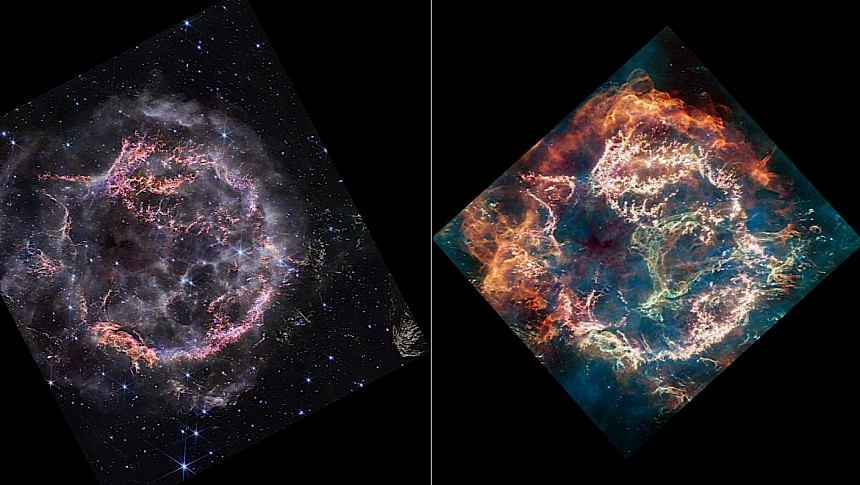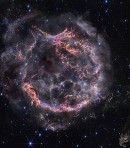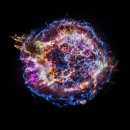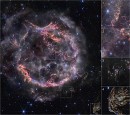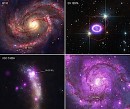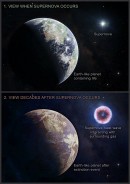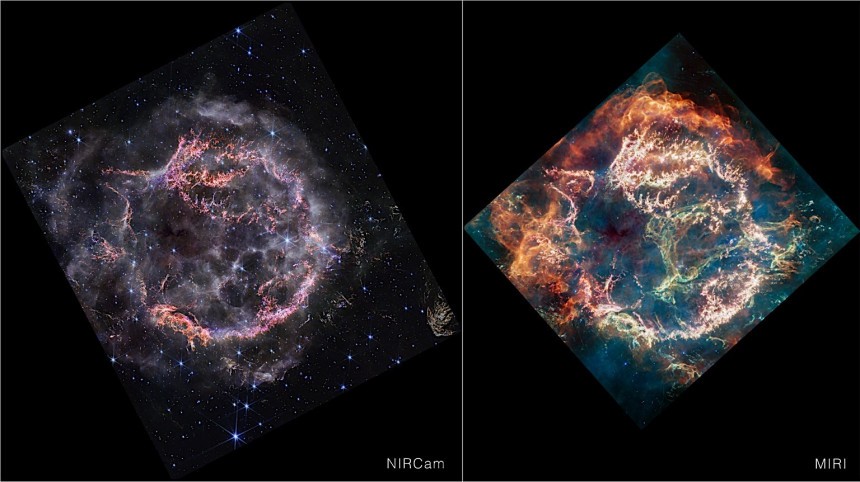We humans are a very destructive species, and as such we've used our innate ingenuity to generate some very impressive explosions. The biggest of them all, the one generated by the Russian Tsar Bomba thermonuclear bomb, was powerful enough to level a village 34 miles (55 km) away, and do significant damage 100 miles (160 km) aways. But even that is nothing compared to what nature is capable of.
Supernovas are described by NASA as "the biggest explosion that humans have ever seen." And that kind of makes sense, considering they are essentially stars going bust. And when stars go bust, they take everything with them.
A supernova occurs when a star runs out of fuel. When that happens, the delicate balance between the fuel trying to escape the sun and the gravity pulling it back in is broken, and that causes the star to collapse on itself.
It takes mere seconds for that to happen, and given the huge mass of stars (to give you an idea, some of these things have about one million times the mass of our own planet), the collapse results in impossible-to-describe shockwaves, accompanied by clouds of hot gas. Some supernovas are so powerful they give birth to black holes, the baddest, meanest space objects we know of.
Not all stars go supernova. For that to happen, they need to be several times more massive than our own Sun (about eight times, that is), which because of its relatively small size will instead turn into a red giant at the end of its life.
Depending on the kind of star that explodes, supernovas are divided into two categories, Type 1 and Type 2, but there are other criteria that set them apart as well, and that can best be seen in their remnants.
And it's exactly this kind of astronomical event the James Webb Space Telescope looked at recently, giving humanity a new "high-definition" look at what's left after a star explosion.
Although impressive by all standards, supernovas are (luckily) not that common. As per NASA, there are probably at most three of them per century in our Milky Way galaxy, making them incredibly difficult to find.
We know of a few, though, and none of them is as studied as the one called Cassiopeia A (Cas A). It's located a staggering 11,000 light years away from our planet and according to estimates it was the result of a star exploding about 340 years ago in the constellation Cassiopeia.
The explosion was massive and left behind its remnants now spreading over 10 light-years across. That's roughly 60 trillion miles (96.5 trillion km), if such a huge number gives you a better sense of things.
Cas A was discovered in 1948 by a pair of astronomers from Cambridge, and as soon as humanity was able to do it, it trained its best telescopes on it. Most recently, we've studied the place with the help of the Chandra X-Ray Observatory, Hubble Space Telescope, and Spitzer Space Telescope.
Now that the Webb Space Telescope, the most powerful (and expensive) such tool is out there doing hard work, we've pointed it to Cas A as well, and the results are simply stunning.
Thanks to the instruments fitted on the Webb, most specifically the ones capable of seeing in near-infrared light, NASA was able to get its hands on the clearest picture of the supernova remnant yet, discovering in it both incredible details and mysteries, "at a resolution previously unreachable at these wavelengths."
The images were captured in April this year, and show "new and unexpected features within the inner shell" of the supernova field, more specifically details of how the still expanding shell of the remnant hits the gas that floats all around it.
The images released by the American space agency are very colorful, not because that's how the place looks, but thanks to the filters that were applied to make infrared light visible to the human eye, which is normally unable to perceive it.
Each color points to a process or element to be found in the supernova remnant. For instance, the clumps of bright pink and orange that make up the inner shell are a mixture of sulfur, oxygen, argon, and neon.
They all come from the star itself, and they are mixed with dust and other molecules. In time (a very long time), these elements will come together to form new planetary systems and even new stars.
Some of the other telescopes that were pointed over time at Cas A have shown a loop of green light in the remnant's central cavity. This feature has been named by astronomers the Green Monster, and it's something that was described as "challenging to understand."
The Webb images we have here do not show the Green Monster, because the infrared camera used does not see it, but the telescope did shed new light on the feature by showing circular holes faintly outlined by white and purple.
It's believed the white and purple are ionized gases resulting from debris from the massive explosion pushing their way through the surrounding gas as it continuously expands.
In the bottom right corner of the images there's something that appears like a mini-Cas A supernova, but that has been determined to be a light echo of the main object. It's caused by the light of the initial blast reaching the dust on the outer edges. Although the main remnant field and the light echo appear to be right next to each other, they are actually some 170 light years apart.
The new Webb images of Cas A are so groundbreaking NASA says they helped astronomers enter a new era of study of the place, one which comes with hints "at the dynamical processes occurring within the supernova remnant," but also "with transformational insight into how this star exploded."
A supernova occurs when a star runs out of fuel. When that happens, the delicate balance between the fuel trying to escape the sun and the gravity pulling it back in is broken, and that causes the star to collapse on itself.
It takes mere seconds for that to happen, and given the huge mass of stars (to give you an idea, some of these things have about one million times the mass of our own planet), the collapse results in impossible-to-describe shockwaves, accompanied by clouds of hot gas. Some supernovas are so powerful they give birth to black holes, the baddest, meanest space objects we know of.
Not all stars go supernova. For that to happen, they need to be several times more massive than our own Sun (about eight times, that is), which because of its relatively small size will instead turn into a red giant at the end of its life.
Depending on the kind of star that explodes, supernovas are divided into two categories, Type 1 and Type 2, but there are other criteria that set them apart as well, and that can best be seen in their remnants.
Although impressive by all standards, supernovas are (luckily) not that common. As per NASA, there are probably at most three of them per century in our Milky Way galaxy, making them incredibly difficult to find.
We know of a few, though, and none of them is as studied as the one called Cassiopeia A (Cas A). It's located a staggering 11,000 light years away from our planet and according to estimates it was the result of a star exploding about 340 years ago in the constellation Cassiopeia.
The explosion was massive and left behind its remnants now spreading over 10 light-years across. That's roughly 60 trillion miles (96.5 trillion km), if such a huge number gives you a better sense of things.
Cas A was discovered in 1948 by a pair of astronomers from Cambridge, and as soon as humanity was able to do it, it trained its best telescopes on it. Most recently, we've studied the place with the help of the Chandra X-Ray Observatory, Hubble Space Telescope, and Spitzer Space Telescope.
Thanks to the instruments fitted on the Webb, most specifically the ones capable of seeing in near-infrared light, NASA was able to get its hands on the clearest picture of the supernova remnant yet, discovering in it both incredible details and mysteries, "at a resolution previously unreachable at these wavelengths."
The images were captured in April this year, and show "new and unexpected features within the inner shell" of the supernova field, more specifically details of how the still expanding shell of the remnant hits the gas that floats all around it.
The images released by the American space agency are very colorful, not because that's how the place looks, but thanks to the filters that were applied to make infrared light visible to the human eye, which is normally unable to perceive it.
Each color points to a process or element to be found in the supernova remnant. For instance, the clumps of bright pink and orange that make up the inner shell are a mixture of sulfur, oxygen, argon, and neon.
Some of the other telescopes that were pointed over time at Cas A have shown a loop of green light in the remnant's central cavity. This feature has been named by astronomers the Green Monster, and it's something that was described as "challenging to understand."
The Webb images we have here do not show the Green Monster, because the infrared camera used does not see it, but the telescope did shed new light on the feature by showing circular holes faintly outlined by white and purple.
It's believed the white and purple are ionized gases resulting from debris from the massive explosion pushing their way through the surrounding gas as it continuously expands.
In the bottom right corner of the images there's something that appears like a mini-Cas A supernova, but that has been determined to be a light echo of the main object. It's caused by the light of the initial blast reaching the dust on the outer edges. Although the main remnant field and the light echo appear to be right next to each other, they are actually some 170 light years apart.
The new Webb images of Cas A are so groundbreaking NASA says they helped astronomers enter a new era of study of the place, one which comes with hints "at the dynamical processes occurring within the supernova remnant," but also "with transformational insight into how this star exploded."
